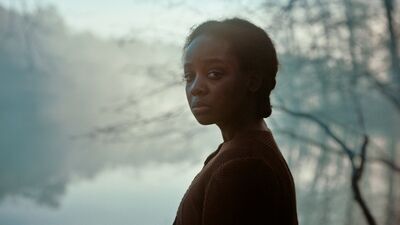From my understanding, “The Gaze” began as five hours of footage before one of the series’ editors fashioned an initial one-hour cut. After that, it went through several more edits, switching footage here and there. As you were editing, did you have an unspoken narrative throughline in mind?
Yeah, I said we were going to go in the show’s chronology. Because there was just so much footage, it helped Daniel Morfesis, who cut it together, have a very simple, logical, organizing principle. The biggest thing that happened from the first version of it to the version that I put on Vimeo was: Okay, when does this become narrative? Or when does something in this become like a clue to narrative in the show? So there were some wonderful portraits in the show that aren’t in “The Gaze,” even though I was like: Ah, this would fit perfectly, right here. I think the only one we kept was the group shot in the cotton field. That’s in both just because that just spoke to everything.

Throughout the series, there is tension between the beauty we’re seeing, the gorgeous photography of these landscapes, and the horrid actions that occurred on them. I think “The Gaze” is the most extreme, particularly because its silence leaves space to both marvel and imagine the sorrow. How did you balance that tension throughout the series?
It wasn’t even about trying to balance it. We made the show so fast, 500 pages in 116 days—that’s about 12 days per hour-long episode. Because of that, we weren’t putting up massive lights and we weren’t waiting for light to shoot at these perfect moments. It’s just in the environment that we’re in. Anywhere you look, something equally barbaric and beautiful is occurring in the frame. I felt very steadfastly it would’ve been false to try to create an image that wasn’t typically beautiful. Because beauty is different depending on a person’s perspective, we would have had to get into the DI and purposely desaturate the image and chop all the highlights. That would’ve been a falsehood in and of itself.
It was something of a journey always to be mindful of because there is a place where, because of the gravity or the graveness of some of the images we were conjuring, it could almost seem in poor taste to record those things with this imagery that is so “beautiful.” And the truth of it was, it was just always there. It was shocking.
The clearest example is the death of Big Anthony, where a kind of celestial light shines through his body.
And that’s just the sun. It is just the sun. And that’s an actual house that has been there for centuries. We were out in the yard where that thing would’ve taken place, and the camera’s just there, moving around, and then it looked over and boom, there it was. Now the choice would’ve been: Okay, well let’s wait until that’s not there. Or let’s not film from this angle. But then what is that doing? This is natural; this is mother nature in the state of Georgia. In this place where I know things like this occurred, the point was, despite all this abject beauty, despite just this splendid landscape, despite the presence of God and the beauty of all this natural environment, these horrific things were still perpetrated on other godly beings—which is absolutely insane. To me, it spoke to the insanity of the enterprise, the madness, the barbarity.

